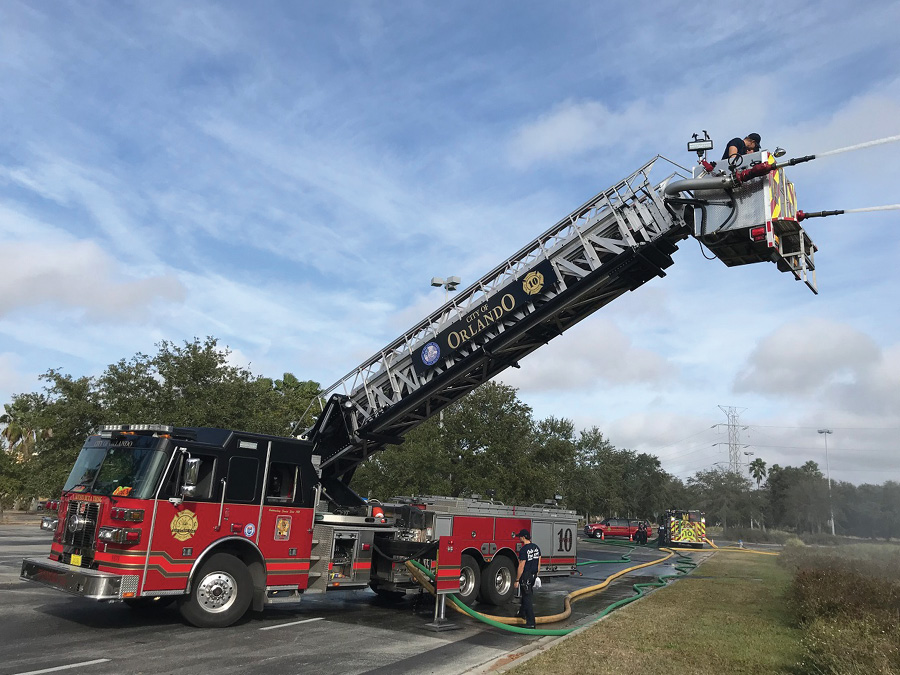
By Michael N. Ciampo
Time after time, firefighters will often be perched a high distance above a structure, pouring water into a raging inferno from a tower ladder bucket. Often, the stream’s pattern is breaking up before it even hits its target because the wind is blowing fiercely or because the distance is so far away from the objective. This can also be true for aerial ladders with prepiped monitor nozzles.

(1) Many times, we don’t have the luxury of aiming into a building when practicing stream deployment. (Photo by J.J. Cassetta.)
Since we often don’t train on flowing into a structure that’s not on fire, much of our learning process comes from squirting water into a parking lot, watching others operate at fires (live or on video), or fireground experiences (photo 1). However, like anything else, there are numerous ways to perform our tasks. Just because we’re being pulled out of a heavily involved structure doesn’t mean we just go to an all-out defensive attack; we must understand that just because we’re pulled out or off a top floor and going to master stream operations, there’s a good chance we might be marching right back in there with handlines if the master streams knocked down the bulk of the fire.
Top-Floor Fires
Many multiple dwellings feature large cocklofts, and row frame buildings have one huge, common cockloft, possibly calling for the need for master stream operations during a significant fire. Firefighters must first understand that the cockloft area of many of these structures is a giant, dried-out lumberyard of wood that, when exposed to flame, will rapidly extend horizontally in many directions.
Age is another feature of these buildings; many are now more than 100 years old and have gas pipelines in the cockloft. These lines were originally for gas lighting the building; they were plugged with wax or fittings and can fail under heat and fire conditions. This makes fire conditions more intense and extend rapidly in the cockloft area.
When we lose control of the top floor and fire is running over our heads, we must retreat to safety quickly and revert to a large water delivery plan into the cockloft. If your department has a cockloft nozzle, using it may keep you from having to retreat from the top floor. Many departments haven’t been exposed to this device yet and, if faced with such a situation, must retreat and go to another firefighting tactic. Hopefully, prior to any of this occurring, the tower ladder chauffeur or one of the first-arriving engines has been trained to stretch a dry supply line to an aerial apparatus operating in front of a structure with a top-floor fire. You can hook the line into the ladder company’s intake in case it is needed; if it’s not, there’s no harm in packing up the dry line at the end of the fire.
As all this is happening on the top floor, units on the roof have (hopefully) been performing vertical ventilation and have created a good-sized hole in the roof. With that much fire in the cockloft, the hole might not be large enough, and they’ll still be working on expanding the cut or even trying to make a trench cut to stop the fire’s extension. Unfortunately, at many of these fires, roof teams will also be chased by the fire or pulled off the roof for their own safety. When this happens, some firefighters who operate the tower or aerial ladder believe that the vent hole created by the roof firefighters is the natural water application area.
This is far from the truth; the hole is there to allow the escaping heat, gases, and smoke to exit. The hole also provides the avenue for all these by-products to escape the cockloft and to be pulled out of the structure since the top-floor windows were, hopefully, removed to create this draft. Shooting the line into the vent hole only serves to drive everything back into the cockloft and push it throughout the cockloft and the structure. Plus, the intact roofing material prevents water from entering the cockloft or building, doing what it was designed to do!
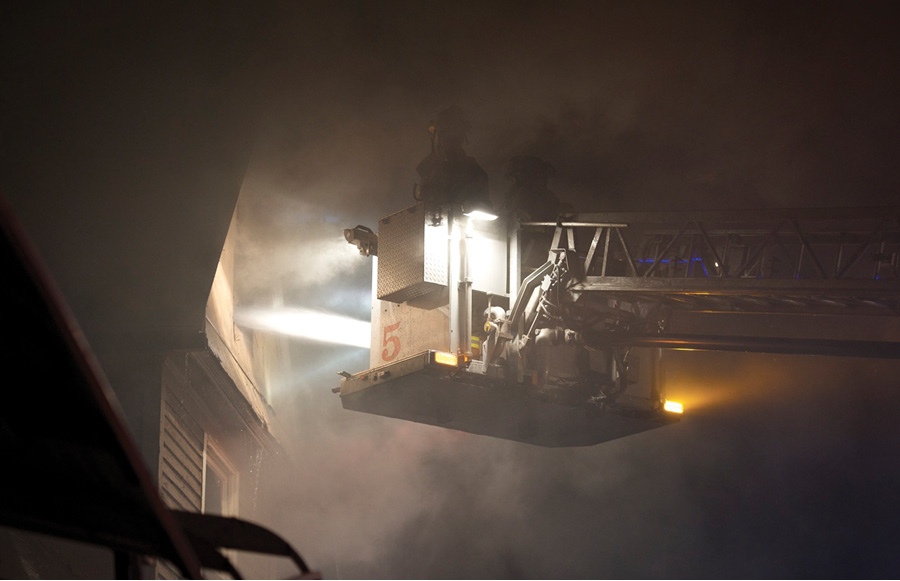
(2) Operating the stream upward and near the window will assist in penetrating the cockloft and also tear open the roof from the underside. (Photo by J.J. Cassetta.)
When the tower ladder or aerial stream is to be directed into the cockloft area, its best position is at a level just below the top-floor windows, low enough to drive the stream up into the cockloft, allowing it to move horizontally (a sweeping motion) along the ceiling joists. The stream must not be a far distance from the window because it can pull additional air into the structure, possibly feeding the fire. In this position, the stream’s power can also knock down ceilings. Many of these older plaster and lath ceilings may have wire mesh embedded in the plaster or may now be covered up with drywall and are difficult for firefighters to pull with hooks. We can use the water’s power to create a hydraulic opening of the cockloft area and overhaul in one shot.
When we operate at this position, removing the window’s glass, curtains, blinds, and center sash with a tool prior to water delivery will give unimpeded access into the cockloft. If time does not permit this, then the water’s powerful stream will do it, but be aware that flying glass, the screen’s frame, and the window’s sash can rain down on members operating in the street (photo 2).
When we position at certain buildings with “throat” sections (the area between the building’s wings), whether it is at a “H”-, an “E”-, or a “Double H”-shaped structure, position the tower ladder’s turntable in the throat. This gives the tower ladder access into numerous top-floor windows, possibly preventing the fire from traveling across the throat and into another wing.
The tower ladder should operate from the deepest position it can and work back toward the front of the wing. Operating in this manner may extinguish the rapidly moving fire and prevent the stream’s power from pushing the fire toward the throat, similar to if we started operating in the front and worked toward the back. Also, when we operate in this manner, roof teams may be able to continue cutting a trench cut across the throat area because the tower ladder keeps the fire from extending toward them.
When operating at multiple dwellings with throats, if the tower ladder initially positions there, it may not be able to reach the front wall’s entire surface area because the fire escape is jutting out from the building. So, if a person is in distress near a top-floor window on the opposite side of the fire escape, position the tower ladder for the rescue first and reposition it later. This should signal to other units responding to alarms to leave open throat areas for access to aerial apparatus to operate their streams from this position.
Tin Cornices
At most multiple dwellings, if fire laps out of the front windows and involves the ornamental tin cornices, realize that the parapet will normally extend behind the cornices and offer no access into the cockloft. During many incidents, fire has moved rapidly along the backside of the cornice’s wood framing and extended horizontally across the front of the building. In New York City, many times the cornice was defective, and pigeon nests that were built inside it ignited the debris rapidly. So, give this area a quick shot with the master stream to possibly knock down the fire and prevent the tin cornice’s metal banding supports from failing and having a section of or the entire cornice collapse to the ground.
Never drive the stream at the building from the tower ladder’s bucket at close range and think you’re applying water into the cockloft. At a recent incident, a fire was extending behind the cornice area rapidly, and when the stream was directed at it, deteriorating bricks flew off the building and became flying projectiles. Luckily, one only brushed a firefighter’s shoulder and caused a minor injury.
Another option is to deploy the stream for several seconds at the cornice area and then back to the top floor, alternating your fire attack plan (photo 3). If you’re using an electric monitor nozzle, you can reduce the chances of breaking off the cornice hanger straps with the straight stream and having the cornice collapse by switching the pattern to a narrow fog pattern.
If a tower ladder is operating below a cornice that was affected by fire, it is imperative that the members operating in the bucket continually perform a size-up of its conditions. These cornices can fail instantaneously and may pull down more than themselves, especially if you are operating at a row frame-type structure. Unlike the multiple dwelling, some row frame structures’ tin cornices or elaborate wooden ornamental work (wrapped with tin), when removed, will allow access into the cockloft.
Opening a hole in a cornice can indicate the structural makeup of the building. Some renovated buildings have had plastic resin ornamental cornices installed on them, which offers yet another way to rapidly extend fire when exposed to heat and flames.
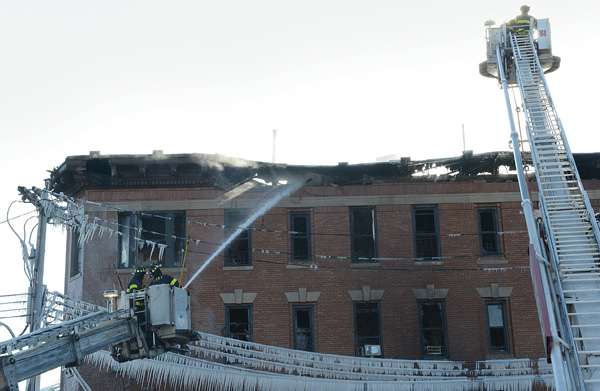
(3) Always use caution while operating near the cornice; it can collapse in an instant when involved with heavy fire conditions or when severely damaged. (Photo by Danny Alfonso.)
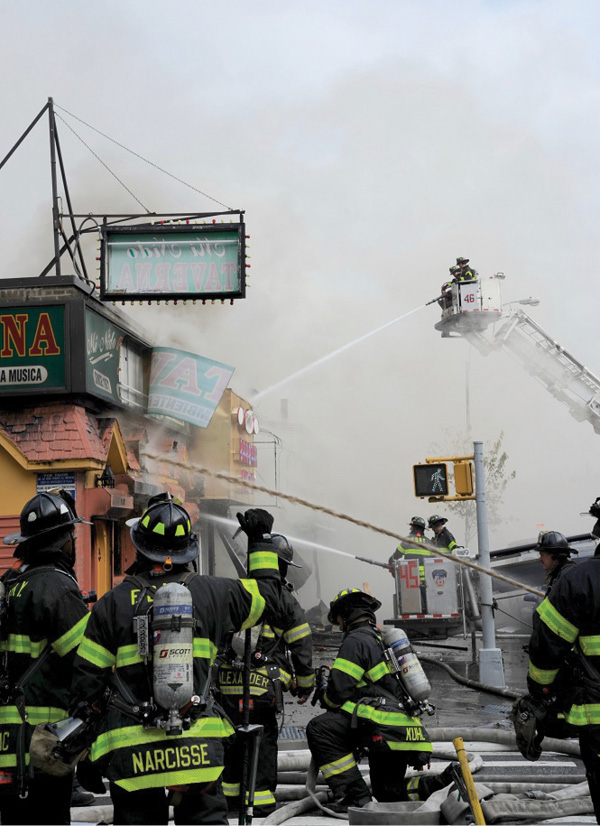
(4) Placing the tower ladder’s bucket onto the sidewalk at taxpayers and strip malls is a great method of applying water into the structure. Always size up the conditions of the parapet before, during, and after operating there. (Photo by Lou Minutoli.)
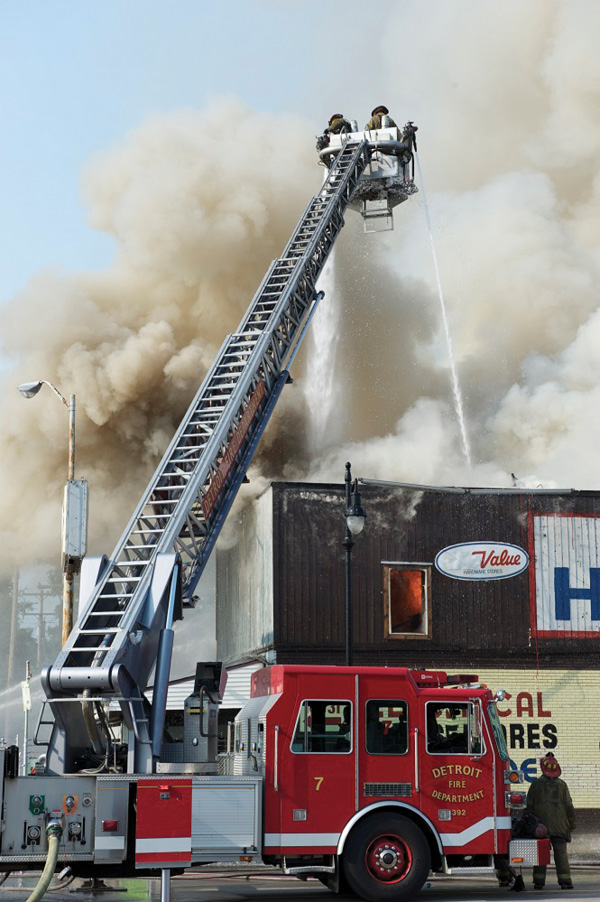
(5) When the roof is sagging or ready to collapse, tower ladders should operate above it so that the walls don’t fall onto the bucket and for overall safety. (Photo by J.J. Cassetta.)
Taxpayers/Strip Malls
One of the tower ladder’s greatest advantages is its ability to go below the apparatus body’s height and position on the ground to deliver a powerful water stream from the street level into a structure. When you withdraw from a taxpayer or strip mall and go to a defensive operation, getting the tower ladder down on the sidewalk and delivering its stream up into the cockloft or plenum space above the ceiling tiles can knock a large amount of fire down quickly (photo 4).
Many older taxpayer buildings contain a common cockloft with a huge amount of wooden structural elements eager to ignite and burn. If you get the bucket on the sidewalk early into the firefight and douse the ceiling areas with the stream, you have a better chance of knocking down a section of the fire or the whole fire. With the tower ladder’s bucket on the ground and the rig properly positioned with the cab angled away, the boom and bucket will be able to make an arc off the side of the rig, covering numerous occupancies with its master stream (often referred to as the “scrub area”).
As with all operations, discuss and be aware of some safety factors for working at taxpayers and strips malls. Size up the building type. If you’re working at a deli, a fast-food mart, or any store that has cooking appliances in the vicinity, be aware of grease ducts running into the cockloft. When these ducts are involved in fire, they can fail at their seams and aid in advancing the fire rapidly in the cockloft area. You must be aware of these conditions, especially when you arrive early in the morning after the occupancy has been closed.
If, on arrival, you have advanced fire in the stores and cockloft, you may have only a few minutes to give the stores a good shot with the tower ladder’s master stream from the sidewalk area. Do this early in the operation while also assigning a member to check the stability of the parapet and look for any bowing of the wall, heavy smoke pushing from cracks, awnings pulling away from the building, and cornice pieces separating from the main parapet.
At multiple-alarm fires in these structures, the Fire Department of New York (FDNY) Tactical Support Unit will set up a transom and monitor the parapet’s condition. If there is any fear of collapse from the initial size-up through ongoing operations, the tower ladder should not operate from street level for overall safety. However, if units are being withdrawn from interior operations, using the tower ladder early can help knock down a substantial amount of fire, keep the fire from extending into other storefronts, and extinguish the fire in the cockloft.
Lessons Learned/Reinforced
Following are some lessons learned and reinforced when responding with and operating the tower ladder:
Prior to operating into any structure, all units must be warned that master stream operations will begin and to watch out for the stream pushing fire debris, components of the building, and by-products of combustion in various directions (photo 5).
In some instances, at taxpayer/strip mall fires, automobiles parked alongside the curb will hinder bucket position on the sidewalk. You may have to place the boom over the hood or trunk of these vehicles to achieve a good offensive attack with the water stream.
Parking meters, street signs, and other obstructions (commuter bus shelters, street vendor equipment, and ticket booths) may also hamper bucket position on the sidewalk. There have been times when street signs and parking meter posts have been cut down close to the sidewalk for firefighting operations.
If the bucket is equipped with a manually operated monitor nozzle, whipping the nozzle up and down and left to right will help tear open ceilings and walls for penetrating to the seat of the fire. If the bucket has an electrically operated monitor nozzle, you can follow the same procedure. However, since this nozzle moves at a slower rate of speed, the destruction and access into the area may take a little more time.
When operating below a parapet, members in the bucket must keep a constant watch over the conditions above them. They can’t rely on others’ reports; their position puts them close to the building, allowing them a better view of the wall than others far away from it. If the smoke is thick and nasty, you may need to pull the unit farther back so the smoke doesn’t ignite and engulf the members operating in the bucket.
Recently, the FDNY experienced a smoke explosion that blew out the front of a store when the rear portion of roof collapsed into the fire. The pancake-type collapse acted like a piston and forced all the by-products of combustion out of the front of the store in a fierce manner. Always wear appropriate safety equipment when operating in front of the store under heavy fire conditions.
Tower ladder officers should monitor water runoff when operating at all fires involving master stream operations. Water-logged floors or stock inside a structure will add a tremendous weight load to a structure on fire, making a collapse a real possibility.
When you encounter heavy fire conditions and initial actions are offensive with units operating inside the structure, it is perfectly fine to stretch a supply line to a ladder company apparatus with master stream capabilities. Remember, be proactive and not reactive; too many times, we react after things have taken a turn for the worse.
Unfortunately, in this profession, we are going to lose structures to the ravages of fire. However, if we are trained to be prepared and operate offensively with the tower ladder’s master stream while we’ve switched to a defensive strategy, we can cut off the fire’s spread, extinguish a large portion of the fire so interior operations can resume, and possibly save other nearby exposures from the extending fire.
Raising the boom over the roof level, squirting water into vent holes, and waiting for the roof to burn off shouldn’t be our primary actions. Those instances occur when we’ve lost the entire building, the roof has collapsed into the structure, and there is an inherent danger of the parapet or entire structure collapsing.
MICHAEL N. CIAMPO is a 33-year veteran of the fire service and a lieutenant in the Fire Department of New York. Previously, he served with the District of Columbia Fire Department. He has a bachelor’s degree in fire science from John Jay College of Criminal Justice in New York City. He is the lead instructor for the FDIC International Truck Essentials H.O.T. program. He wrote the Ladders and Ventilation chapters for Fire Engineering’s Handbook for Firefighter I and II (Fire Engineering, 2009) and the Bread and Butter Portable Ladders DVD and is featured in “Training Minutes” truck company videos on www.FireEngineering.comcompany videos on www.FireEngineering.com.
RELATED
Tower Ladder Bucket Positioning
Tower Ladder Placement
Alider Pratts: Tower Ladder Operations
Transporting Portable Ladders with the Tower Ladder Bucket
TOWER LADDERS: POSITIONING TIPS AND TECHNIQUES

